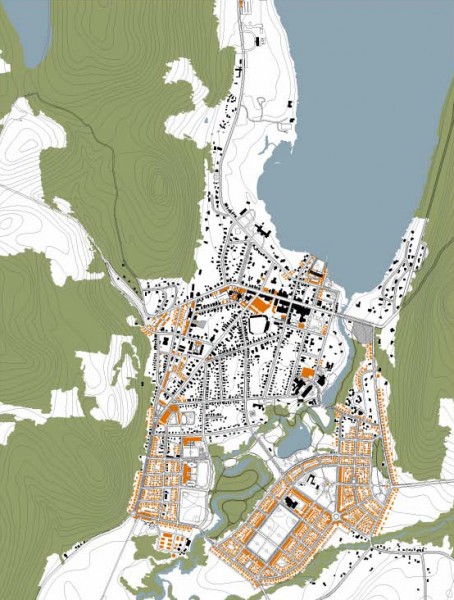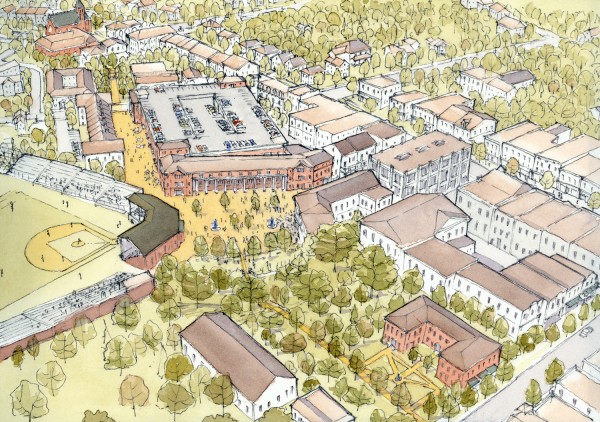 Cooperstown (2007): Located on the southern edge of Otsego Lake and at the headwaters of the Susquehanna River, Cooperstown is a village in upstate New York best known as home to the National Baseball Hall of Fame and Museum, but also for several other museums, a world-class resort and golf course, and a major regional hospital. Known to some as ‘America’s Most Perfect Village,’ Cooperstown is nevertheless beset by housing, traffic, landscape and revenue problems common to small post-1945 rural communities. The Notre Dame graduate urban design studio was commissioned by the Cooperstown, NY Village Board of Trustees to identify and begin to address those problems; and from September through December 2007, beginning with an eight-day on-site design charrette, Notre Dame graduate urban design students undertook an analysis of the assets possessed by and the challenges facing Cooperstown, and how good design and public policy could help address those challenges. The end result was the Plan of Cooperstown, a collection of images and guidelines that address a variety of local development issues, and proposals the implementation of which would allow Cooperstown to respond to regional population and traffic pressures that threaten its character by growing as Cooperstown has always done: as a walkable mixed-use village.
Cooperstown (2007): Located on the southern edge of Otsego Lake and at the headwaters of the Susquehanna River, Cooperstown is a village in upstate New York best known as home to the National Baseball Hall of Fame and Museum, but also for several other museums, a world-class resort and golf course, and a major regional hospital. Known to some as ‘America’s Most Perfect Village,’ Cooperstown is nevertheless beset by housing, traffic, landscape and revenue problems common to small post-1945 rural communities. The Notre Dame graduate urban design studio was commissioned by the Cooperstown, NY Village Board of Trustees to identify and begin to address those problems; and from September through December 2007, beginning with an eight-day on-site design charrette, Notre Dame graduate urban design students undertook an analysis of the assets possessed by and the challenges facing Cooperstown, and how good design and public policy could help address those challenges. The end result was the Plan of Cooperstown, a collection of images and guidelines that address a variety of local development issues, and proposals the implementation of which would allow Cooperstown to respond to regional population and traffic pressures that threaten its character by growing as Cooperstown has always done: as a walkable mixed-use village.
Cooperstown (2007)
 Cooperstown (2007): Located on the southern edge of Otsego Lake and at the headwaters of the Susquehanna River, Cooperstown is a village in upstate New York best known as home to the National Baseball Hall of Fame and Museum, but also for several other museums, a world-class resort and golf course, and a major regional hospital. Known to some as ‘America’s Most Perfect Village,’ Cooperstown is nevertheless beset by housing, traffic, landscape and revenue problems common to small post-1945 rural communities. The Notre Dame graduate urban design studio was commissioned by the Cooperstown, NY Village Board of Trustees to identify and begin to address those problems; and from September through December 2007, beginning with an eight-day on-site design charrette, Notre Dame graduate urban design students undertook an analysis of the assets possessed by and the challenges facing Cooperstown, and how good design and public policy could help address those challenges. The end result was the Plan of Cooperstown, a collection of images and guidelines that address a variety of local development issues, and proposals the implementation of which would allow Cooperstown to respond to regional population and traffic pressures that threaten its character by growing as Cooperstown has always done: as a walkable mixed-use village.
Cooperstown (2007): Located on the southern edge of Otsego Lake and at the headwaters of the Susquehanna River, Cooperstown is a village in upstate New York best known as home to the National Baseball Hall of Fame and Museum, but also for several other museums, a world-class resort and golf course, and a major regional hospital. Known to some as ‘America’s Most Perfect Village,’ Cooperstown is nevertheless beset by housing, traffic, landscape and revenue problems common to small post-1945 rural communities. The Notre Dame graduate urban design studio was commissioned by the Cooperstown, NY Village Board of Trustees to identify and begin to address those problems; and from September through December 2007, beginning with an eight-day on-site design charrette, Notre Dame graduate urban design students undertook an analysis of the assets possessed by and the challenges facing Cooperstown, and how good design and public policy could help address those challenges. The end result was the Plan of Cooperstown, a collection of images and guidelines that address a variety of local development issues, and proposals the implementation of which would allow Cooperstown to respond to regional population and traffic pressures that threaten its character by growing as Cooperstown has always done: as a walkable mixed-use village.



